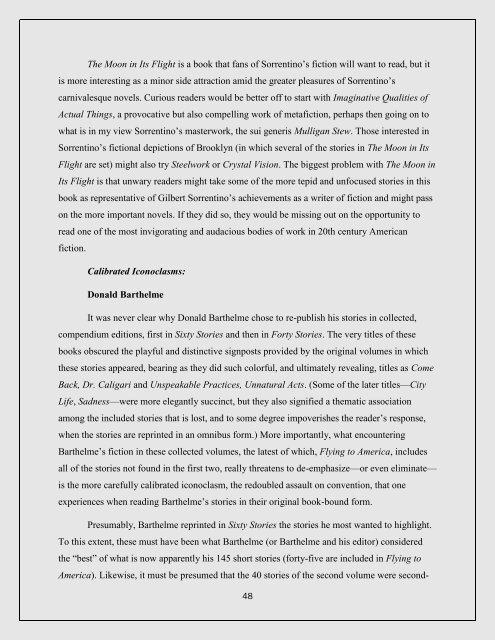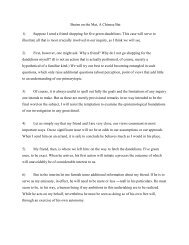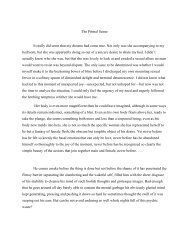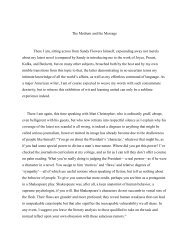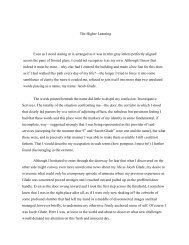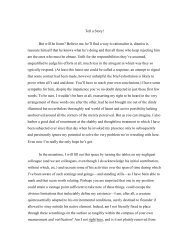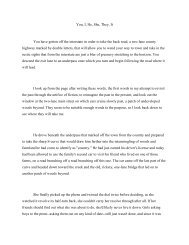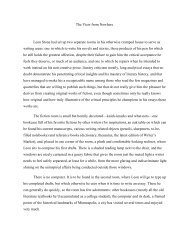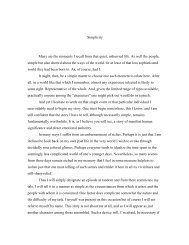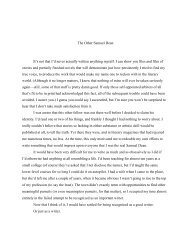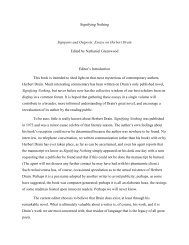APF
Create successful ePaper yourself
Turn your PDF publications into a flip-book with our unique Google optimized e-Paper software.
The Moon in Its Flight is a book that fans of Sorrentino’s fiction will want to read, but it<br />
is more interesting as a minor side attraction amid the greater pleasures of Sorrentino’s<br />
carnivalesque novels. Curious readers would be better off to start with Imaginative Qualities of<br />
Actual Things, a provocative but also compelling work of metafiction, perhaps then going on to<br />
what is in my view Sorrentino’s masterwork, the sui generis Mulligan Stew. Those interested in<br />
Sorrentino’s fictional depictions of Brooklyn (in which several of the stories in The Moon in Its<br />
Flight are set) might also try Steelwork or Crystal Vision. The biggest problem with The Moon in<br />
Its Flight is that unwary readers might take some of the more tepid and unfocused stories in this<br />
book as representative of Gilbert Sorrentino’s achievements as a writer of fiction and might pass<br />
on the more important novels. If they did so, they would be missing out on the opportunity to<br />
read one of the most invigorating and audacious bodies of work in 20th century American<br />
fiction.<br />
Calibrated Iconoclasms:<br />
Donald Barthelme<br />
It was never clear why Donald Barthelme chose to re-publish his stories in collected,<br />
compendium editions, first in Sixty Stories and then in Forty Stories. The very titles of these<br />
books obscured the playful and distinctive signposts provided by the original volumes in which<br />
these stories appeared, bearing as they did such colorful, and ultimately revealing, titles as Come<br />
Back, Dr. Caligari and Unspeakable Practices, Unnatural Acts. (Some of the later titles—City<br />
Life, Sadness—were more elegantly succinct, but they also signified a thematic association<br />
among the included stories that is lost, and to some degree impoverishes the reader’s response,<br />
when the stories are reprinted in an omnibus form.) More importantly, what encountering<br />
Barthelme’s fiction in these collected volumes, the latest of which, Flying to America, includes<br />
all of the stories not found in the first two, really threatens to de-emphasize—or even eliminate—<br />
is the more carefully calibrated iconoclasm, the redoubled assault on convention, that one<br />
experiences when reading Barthelme’s stories in their original book-bound form.<br />
Presumably, Barthelme reprinted in Sixty Stories the stories he most wanted to highlight.<br />
To this extent, these must have been what Barthelme (or Barthelme and his editor) considered<br />
the “best” of what is now apparently his 145 short stories (forty-five are included in Flying to<br />
America). Likewise, it must be presumed that the 40 stories of the second volume were second-<br />
48


